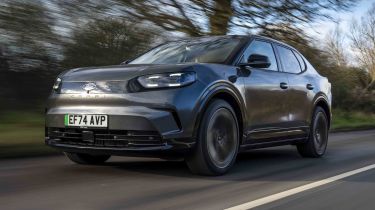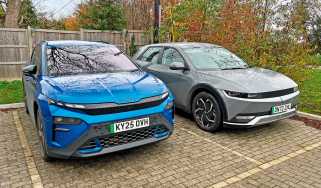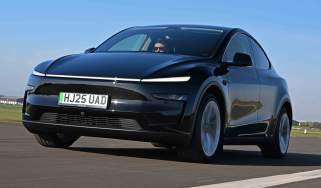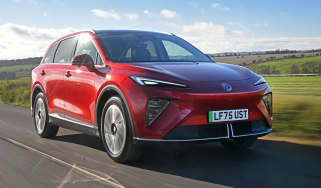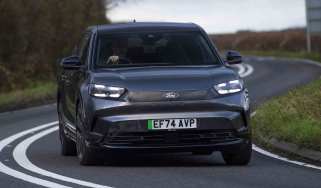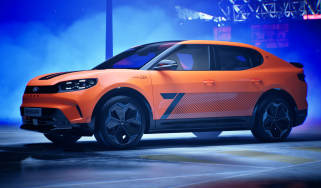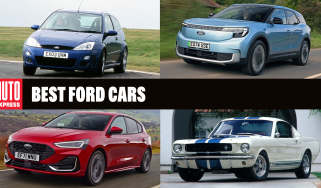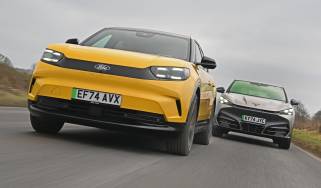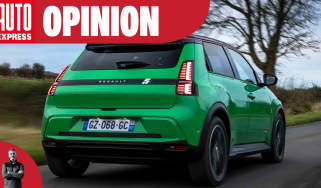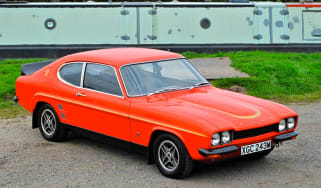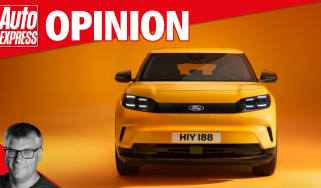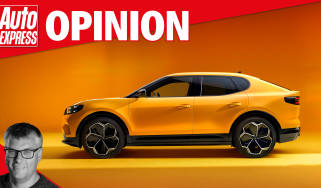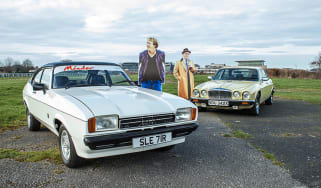Ford Capri review
Look beyond the controversial name, and the Ford Capri is a refined and well built EV

Our opinion on the Ford Capri
Lovers of the classic Ford Capri need not apply, but for everyone else, the latest Capri is a well executed mid-size electric SUV with a smart interior and impressive powertrains that are sourced from Volkswagen, but have been given a makeover by Ford’s engineers. There’s not much added substance over the closely related Ford Explorer beyond the Capri’s different exterior design, and it doesn’t offer a hugely engaging driving experience to go with the sporty styling. But if the Capri’s expressive exterior design floats your boat and you can stomach the high price tag, then there’s every reason to consider it.
About the Ford Capri
Sitting alongside the Explorer in Ford’s range, the electric Capri SUV adopts a sportier, more rakish look, which in places makes the most subtle nods to its fastback namesake. The slim grille is flanked by slightly squared-off headlights, plus there’s a thin blacked-out lighting strip at the back, and both hint to the classic Ford Capri, as do the rounded rear quarterlights ahead of the C-pillars – but some might find that the resulting profile has more than a whiff of Polestar 2 about it.
From a mechanical standpoint, Ford hasn’t created a ground-up EV like the Ford Mustang Mach-E; instead, the Capri is based on the Volkswagen Group MEB platform, just like the Explorer. This means that in some areas the Capri feels like a Ford, but in others the VW DNA can be easy to spot.
All versions come well equipped, with the Style trim getting 19-inch alloy wheels, LED lights front and rear, and a movable 14.6-inch portrait touchscreen. Our preferred mid-range Select trim adds heated front seats, an electrically adjustable driver’s seat with memory settings and a massage function, plus wireless phone charging. The top-of-the-range Premium trim has larger 20-inch alloys, matrix-LED headlights, an electric tailgate with hands-free operation, a panoramic glass roof and an upgraded B&O sound system.
Ford Capri prices and latest deals
Retail prices for the Ford Capri start from around £41,500 for the Style model that comes exclusively with a 52kWh battery. Select trim is around £6,500 more than that, but it does come with the larger 77kWh battery. Premium trim kicks off at around £46,000 with the small battery, or £52,000 with the big battery, while the 79kWh AWD model is another £4,000 on top of that. These are the recommended retail prices, but if you try the Auto Express Buy A Car portal, you should be able to find discounts from selected retailers.
Performance & driving experience
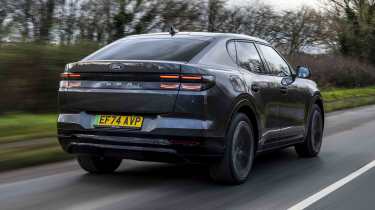
Pros |
|
Cons |
|
It feels like Ford has pulled a fast one on the VW Group here, because for all the MEB SUVs that the German giant currently offers, the Capri delivers a better compromise between ride and handling balance than any of them.
Performance, 0-60mph acceleration and top speed
One of those easy-to-spot areas where Volkswagen’s input can be seen is the battery and powertrain tech, with a glance over the facts and figures confirming they’re uncannily similar to those of the Volkswagen ID.4, Skoda Enyaq and Cupra Tavascan. The single-motor Standard Range is the entry point and produces 168bhp and 310Nm of torque, which offers a 0-62mph of 8.7 seconds, which isn’t the fastest for an EV, but is quicker than most petrol SUVs of a similar size.
There’s then a big step up – in terms of power and price – to the Extended Range model. This Capri has a 282bhp single rear-mounted motor that produces a 0-62mph time of 6.4 seconds. The Extended Range costs around £6,000 more than the Standard Range model.
It’s possible to go even quicker with the AWD Extended Range. This makes the most of a twin-motor set-up that produces 335bhp and 540Nm to allow for a 0-62mph time of just 5.3 seconds. The AWD model gets a larger 79kWh battery.
| Model | Power | 0-62mph | Top speed |
| Capri Standard Range | 168bhp | 8.7 seconds | 99mph |
| Capri Extended Range | 282bhp | 6.4 seconds | 111mph |
| Capri Extended Range AWD | 335bhp | 5.3 seconds | 111mph |
Town driving, visibility and parking
We have tested the Capri on optional 21-inch alloy wheels, which are the biggest available. Despite this large diameter, plus the low-profile tyres, the Ford’s ride didn’t feel harsh. While it had a firmness to it overall – more so than you’d find from the Skoda Enyaq or VW ID.4, for example – the well judged damping prevented much in the way of crashiness or jostling inside the cabin.
Elsewhere, the controls are all neatly weighted and precise. While the transition between motor regeneration and mechanical braking is fairly slick, it’s a shame that the choices of deceleration are limited when you lift the accelerator. Select Sport mode and you get a moderate level of retardation, but otherwise the choice is between almost complete freewheeling and heavy regen (plus an irritating adaptive mode, which we turned off, although only after plenty of burrowing through the infotainment sub-menus).
In this area, we much prefer the systems you’ll find on the likes of the Hyundai Ioniq 5, whose steering wheel-mounted paddles allow the driver to much more precisely tailor the level of regeneration to their tastes.
Country road driving and handling
That braking gripe aside, the Capri drives very smartly for a car in this class. There are rivals that feel a touch more agile – the Renault Scenic is one example – and others, such as the Skoda Enyaq, which ride a little more softly. Yet few, if any, strike such a sweet balance between the two as the Ford. That quality of damping translates into great body control along an undulating road.
Body roll is well judged, and the suspension is firm enough to contain a fairly significant kerbweight (nearly 2.2 tonnes in the top-spec car), yet offers enough movement to show how the Capri is behaving as the tyres load up. The throttle is responsive but still linear, although if you’re a little too aggressive with the accelerator in cold, damp conditions, the front tyres will give up traction before the rears.
Motorway driving and long-distance comfort
Tyre roar is the most noticeable sound that you can hear at speed, but overall, the Capri is still a hushed environment for a motorway cruise. That firmer-than-average suspension set-up translates into great high-speed stability, too.
"Pin your foot to the floor, and there’s no rampant acceleration, rather a gentle surge that makes light work of the Capri’s near-2.1 tonne weight. The powertrain is also impressively refined, with no discernible motor whine and good throttle calibration. As with VW, Ford offers two levels of regenerative braking, with the standard ‘D’ coming with very gentle regen akin to standard engine braking on an internal combustion engine (ICE) car, with ‘B’ increasing this to a more forceful level. It won’t bring you to a complete stop, mind." – Jordan Katsianis, senior staff writer
Range, charging & running costs

Pros |
|
Cons |
|
During our time testing the top-of-the-range AWD model, the Capri averaged 3.3 miles per kilowatt hour. That’s something of a pessimistic view of what it can achieve, though, because the weather was cold and damp, which clearly had an effect.
We’d expect the Capri to achieve closer to 4.0mi/kWh in warm weather, including lots of motorway miles. It’s a shame that a heat pump is only offered as an option; given the car’s price, we feel it should be standard.
Electric range, battery life and charge time
That warm-weather figure for the AWD Capri translates into a real-world range of 316 miles (against the claimed 346 miles), while our winter mileage worked out at 261 miles. Officially, the AWD model has a WLTP-tested figure of 346 miles, which is 43 miles less than the 77kWh car, at 389 miles. Obviously, the smaller battery in the Standard Range model can’t match these figures, with a WLTP figure of 242 miles quoted.
Charging is at its best in the AWD model, where it reaches 185kW. With some battery preconditioning, the Capri will hit those speeds on a charger that can keep up, which meant that we found the claimed 26 minutes for a 10-80 per cent top up was entirely achievable. Charging in the 52kWh car maxes out at 145kW. Curiously, the mid-range 77kWh models charge at the slowest rate of 135kW.
| Model | Battery size | Range | Insurance group |
| Capri Standard Range | 52kWh | 242 miles | 21 |
| Capri Extended Range | 77kWh | 389 miles | 29 |
| Capri Extended Range AWD | 79kWh | 346 miles | 33 |
Insurance groups
The entry-level Ford Capri in Style trim sits in a low (for an electric car) grouping of 21, which is quite a bit less than the Renault Scenic that starts in group 33. The more powerful 282bhp 77kWh Extended Range Capri is in group 29, while the most potent four-wheel drive AWD version tops out in group 33. However, it’s worth noting that the platform-sharing Explorer sits in one group lower than the Capri across the line-up.
Tax
Unfortunately, electric cars such as the Capri are no longer exempt from vehicle excise duty (VED) charges, so it will attract a first-year VED rate of £10, rising to £190 per year thereafter. Given that no version of the Capri comes in under the £40,000 threshold, you will also have to pay the additional luxury car tax from the second time the vehicle is taxed up until it is six years old.
Benefit-in-Kind company car tax is charged at the lowest three per cent rate for 2025/26, as per all EVs, but this rate will slowly increase year on year to five per cent by 2027/2028. This is still significantly lower than for most petrol or hybrid cars, though.
Depreciation
Depending on trim level, the Capri is predicted to hold on to between 50-53 per cent of its original value after three years or 36,000 miles. That’s better than the Skoda Enyaq Coupé (40-42 per cent), the VW ID.5 (43-46 per cent) and much better than the Ford Mustang Mach-E (36-40 per cent).
But it’s worth noting that the less expensive and more practical Ford Explorer is predicted to hold on to between 50-55 per cent of its value. Those numbers are largely similar to the Renault Scenic E-Tech and the Tesla Model Y.
To get an accurate valuation on a specific model check out our free car valuation tool...
Interior, design & technology
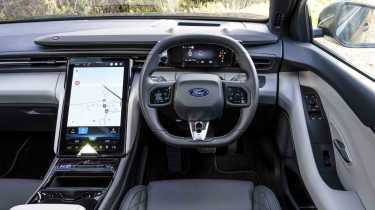
Pros |
|
Cons |
|
A modern design and a well finished cabin make the Capri a nicer place to sit than many of the VW Group alternatives, although some of our complaints about the various MEB-based cars have been carried over here.
Interior and dashboard design
The Capri’s cabin is identical to the Explorer's, so it’s neatly laid out without being flashy or irritating to use. It is modern and crisp, and makes the Mustang Mach-E feel a bit cheap. Some of the Capri’s shortcomings inside betray its VW Group origins. The most irritating is on the driver’s door, where there are just two electric-window switches; if you want to lower the rear windows, you need to press a touch-sensitive button labelled ‘Rear’, which then changes the function of the physical buttons. Why four buttons weren’t used instead still baffles us.
Materials and build quality
There was a time when Volkswagen could rightly claim to have the best-finished cabins in their class. It was slightly awkward, then, that the Skoda Enyaq appeared and felt much better finished than the equivalent ID.4.
Now, Ford has added to that awkwardness because the Capri feels like a nicer place to sit than the VW, too. But while the finish is impressive, it’s still not quite on the level of the fanciest cabin in the segment, which belongs to the Peugeot E-3008.
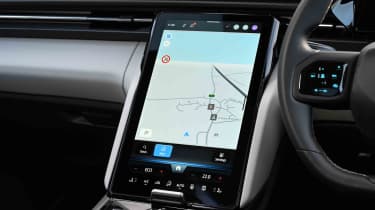
Infotainment, sat-nav and stereo
Ford infotainment systems have come on leaps and bounds in recent years, although in some areas, such as loading times, they still can’t quite live with the best around. The latest SYNC system in the Capri is among the manufacturer’s better attempts.
The large 14.6-inch portrait-orientated touchscreen means that all of the important features can occupy the display at the same time, so switching between modes is easy. Some functions, such as configuring the Capri’s various driver-assist systems and changing driving modes are more fiddly than they should be, though.
We have tested the Capri with the upgraded 10-speaker B&O sound system. We’ve found that at the more affordable end of the market, Ford’s B&O set-ups are among the clearest and punchiest around, and true to form the Capri’s audio is a cut above most of the alternatives at this price level.
Ford’s renowned QuickClear windscreen isn’t available on the Capri, which is no doubt another side effect of its MEB platform.
"One of the Capri’s most distinctive interior features also hides a useful Easter egg. The angle of that huge 14.6-inch touchscreen can be adjusted by up to 30 degrees into a near vertical position. Not only is this a sound idea to avoid any potential glare while driving, but by sliding the screen upwards, it reveals a useful extra hidden cubby area behind the display. That’s handy, because the glovebox is small. Fortunately, there’s also a huge central storage bin, which includes modular cup-holders that can be completely removed." – Alex Ingram - Chief reviewer
Boot space, comfort & practicality
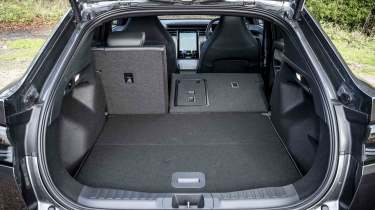
Pros |
|
Cons |
|
The Capri’s cabin and boot space are impressive, although the Explorer offers similar space for less money.
Dimensions and size
There are only marginal differences in size between the Capri and Explorer, but the former does have more boot space overall.
| Dimensions comparison | |||
| Model | Ford Capri | Ford Explorer | Renault Scenic |
| Length | 4,634mm | 4,468mm | 4,470mm |
| Width | 1,872mm | 1,871mm | 1,864mm |
| Height | 1,626mm | 1,630mm | 1,572mm |
| Wheelbase | 2,760mm | 2,767mm | 2,785mm |
| Boot space | 567-1,505 litres | 465-1,455 litres | 545-1,670 litres |
Seats & passenger space
The Capri’s driving position is fairly lofty and the seat and the steering wheel have plenty of adjustment, although some testers found that the front seats are a little heavy on lower lumbar support. The Capri’s slightly squared-off steering wheel means that there’s a large opening to view the digital dials. But unlike in the Volkswagen ID.5, where the display adjusts with the steering column, here it is fixed. Visibility is adequate, but that subtlest of references to the original Capri, the rear side window, actually compromises visibility.
While the Capri offers roughly 60mm less headroom than the more upright Explorer, overall headroom is still impressive despite that swoopy roofline. There’s also loads of space to stretch out. The Capri beats the Mach-E for headroom, but the Mustang has better kneeroom. A flat floor means that legroom in the Capri is still generous, but the centre seat feels a little bit perched. Big door pockets mean that there’s more than enough storage space in the back, too.
Boot space
Despite that notchback shape to the boot lid, the Capri has a 572-litre boot. Premium models feature a powered tailgate as standard. Behind the wheelarch intrusions are a pair of deep cubbies, one of which has a removable bin, while the two-piece false floor allows the rear area to be divided up. The seats don’t quite fold flat but leave a near-level load area, which grows to 1,505 litres in two-seat mode. It’s a shame that there is no front boot.
"With the release of the Capri and Explorer, I really wonder what place is left in Ford’s range for the Mustang Mach-E. The pair have the Mach-E beaten in plenty of areas; they’re more efficient, more comfortable, and while the Mustang’s cabin is let down by a cheap-looking steering wheel and sparse cabin, the newcomers feel much better appointed. There is the range-topping Mach-E GT, of course, which is far quicker, but fast EV fans would be far better served by a Hyundai Ioniq 5 N anyway." – Alex Ingram - Chief reviewer
Reliability & safety
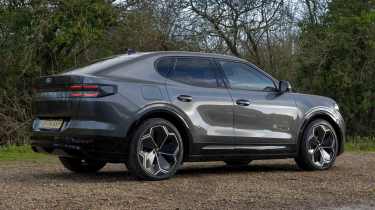
Pros |
|
Cons |
|
By sharing many of the technical components with Volkswagen, the Ford Capri should be rid of any technical bugs that occur with new-generation introductions. In fact, this is something that Volkswagen has had to battle with, with lots of work having been done behind the scenes to avoid repeat issues.
As such, while we don't have any Driver Power data for the Capri yet, we predict that hardware issues and software bugs will be largely addressed. Ford’s own delays to the Explorer and Capri have given the company’s engineers some breathing space to ensure that the cars that hit the road are ready, not rushed.
Euro NCAP has awarded the Capri the maximum five-star safety rating. The Renault Scenic was ahead in the child occupant and safety assistance categories, but the Capri scored better in adult occupancy and vulnerable road user testing.
Most active and passive safety features are fitted as standard, but an optional Driver Assistance package incorporates high-end inclusions such as Driver Alert, Lane Centring and active Lane Change Assist alongside other elements like a 360-degree parking camera and an excellent head-up display.
| Euro NCAP safety ratings | |
| Euro NCAP safety rating | Five stars (2024) |
| Adult occupant protection | 89% |
| Child occupant protection | 86% |
| Vulnerable road user protection | 80% |
| Safety assist | 72% |
Buying and owning
Best buy: Ford Capri Extended Range Select
The Select model has smaller wheels than Premium trim so should ride even more smoothly, while the rear-drive 77kWh battery layout will deliver a range of 389 miles, according to the official figures.
Ford offers a three-year, 60,000-mile warranty, which is only average for the new-car market. This is not as good as you’ll find on some rival cars, which now offer up to five years, or the industry benchmarks from Korea and China, which have seven years of warranty cover.
As with the Explorer, the Capri matches every other EV using VW’s MEB electric car platform by offering 24-month, unlimited mileage service intervals.
Ford Capri alternatives
Compared with rivals, the Capri looks pricey, being a few thousand pounds more expensive than mainstream competitors with similar battery and range figures.
These include the excellent Kia EV6, which has just been updated with a greater capacity 84kWh battery and fresh tech and styling. Pricing starts at £45,500, and in our opinion, is the Capri’s most complete rival. The Hyundai Ioniq 5 isn’t quite as resolved to drive as the Kia, but it is available for less than £40,000 because it can be fitted with a smaller 63kWh battery. Looking at European competition, the firm-riding but stylish Peugeot E-3008 starts at around £46,000, with the closely related Vauxhall Grandland a relative bargain at roughly £36,500 in electric form.
The Volkswagen Group and its shared powertrain also offer a variety of potential rivals, from the Volkswagen ID.4 and Volkswagen ID.5, which start at around £39,500 and £41,000, respectively, or if you’re after something more striking to look at, there is the Cupra Tavascan at around £47,500. The long and short is, if you’re looking at something at this point of the EV market, there are plenty of options, making the Capri’s job that much harder.
Deals on the Ford Capri and alternatives
Frequently Asked Questions
Look beyond the headlines, and the Capri is a decent electric coupé-SUV, but it’s one that has a major fight on its hands for sales. Cars like the Renault Scenic and Kia EV6 are better options, while the Ford Explorer has much of what the Capri offers in a package that’s not quite as expensive.
